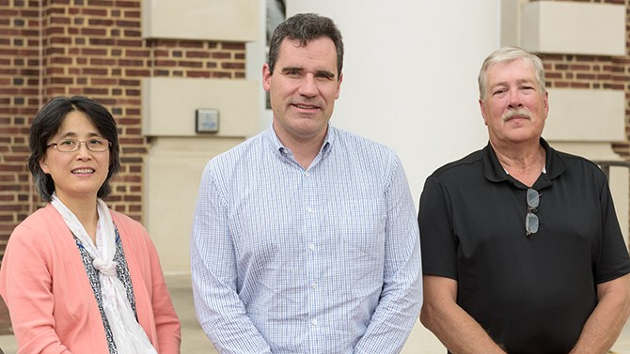Team to create realistic model of human vocal cords
Our vocal cords, two multilayered folds of tissue located above the trachea, produce voice when air passes between them and sets them into vibration.
Various environmental, mechanical and pathological factors can damage this delicate tissue, resulting in a wide spectrum of voice disorders that affect millions of Americans.
Current treatment options for vocal fold disorders are limited, and the development of new procedures has been slow due to the inaccessibility of the tissue and its susceptibility to damage. Further, the unique structure and properties of human vocal folds are not accurately reflected in animal models, so discoveries made from animal tissues cannot be translated to those of humans.

Xinqiao Jia, associate professor in the Department of Materials Science and Engineering, Joseph Fox, professor in the Department of Chemistry and Biochemistry, Randall Duncan, professor in the Department of Biological Sciences. Photo by Evan Krape
Now, a team of researchers at the University of Delaware has received a five-year grant from the National Institutes of Health to engineer a tissue model that can be used to investigate vocal fold development, health, and disease, and more importantly, to facilitate the development and testing of new treatment options.
Xinqiao Jia, principal investigator on the project, explains that existing vocal fold models are made of several types of rubber to reflect the textures of the various layers making up the vocal cords. However, these models do not allow for cellular-level investigation, nor do they accurately reflect the graded nature of the transitions from one layer to the next.
Jia, whose background lies in materials science and tissue engineering, will work with UD’s Joseph Fox, with expertise in organic chemistry, and Randall Duncan, who brings knowledge in cell and molecular biology. The team also includes Susan Thibeault from the University of Wisconsin and Luc Mongeau from McGill University.
The researchers will first create a hydrogel-based platform with well-defined spatial gradients to promote tissue growth. They will then use that scaffold to produce and characterize the epithelial cover. Finally, they will cultivate the cell-populated hydrogels in a bioreactor that simulates human phonation.
“Overall, the combination of a tissue-mimetic hydrogel, primary human cells and a vibratory culture device offers an exciting opportunity for the engineering of reliable and viable vocal fold tissue models,” says Jia.
“This platform will enable us to study vocal cord development, phonation, and trauma and provide a foundation for treating vocal cord disorders.”
About the research team
Xinqiao Jia is an associate professor in the Department of Materials Science and Engineering, with a joint appointment in the Department of Biomedical Engineering.
Joseph Fox is a professor in the Department of Chemistry and Biochemistry, with a joint appointment in the Department of Materials Science and Engineering.
Randall Duncan is a professor in the Department of Biological Sciences, with a joint appointment in the Department of Biomedical Engineering.
Susan Thibeault is the Diane M. Bless Endowed Chair in Otolaryngology at the University of Wisconsin–Madison.
Luc Mongeau is a professor in the Department of Mechanical Engineering and the Department of Biomedical Engineering at McGill University in Montreal, Canada.
– Article by Diane Kukich
*Source: University of Delaware
